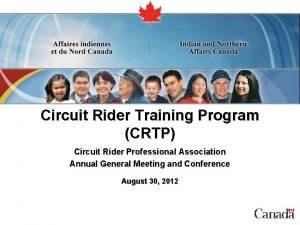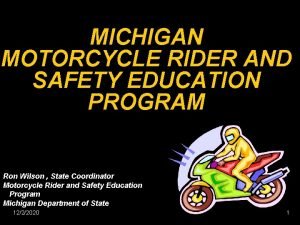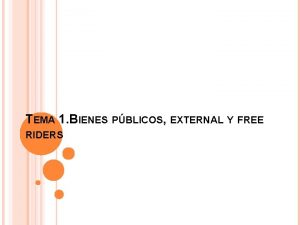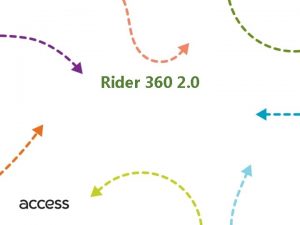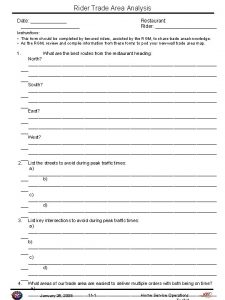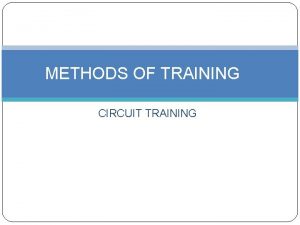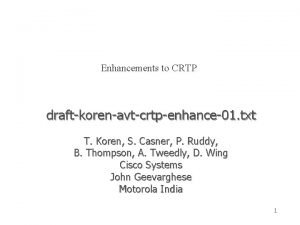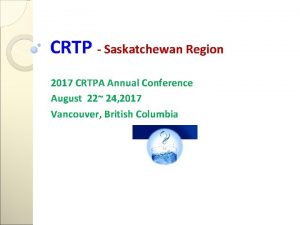Circuit Rider Training Program CRTP Circuit Rider Professional













- Slides: 13

Circuit Rider Training Program (CRTP) Circuit Rider Professional Association Annual General Meeting and Conference August 30, 2012

Purpose of this presentation: Provide an overview of: § Objectives for the standardization of Circuit Rider Training Program (CRTP) § New CRTP Guidelines § Implementation plan for the new CRTP Guidelines 2

Why national standards? § A nationally-funded, capacity building program serving First Nation communities should operate at a level of consistency in order to provide fair, equitable and quality services to the communities. § Over the years, the CRTP has evolved region by region at varying levels of efficiency and cost. § Generally, the goal in the current exercise is to standardize: § § Minimum service base-lines to be provided by CRTs Work plans (and other relevant documents) Cost of services Reporting requirements (standard forms, timing and frequency) Page 3

New CRTP guidelines § Aboriginal Affairs and Northern Development Canada (AANDC) provides funding for the hands-on training and mentoring of operators of water and wastewater systems in First Nations communities through the Circuit Rider Training Program (CRTP). § CRTP Guidelines have been developed and expanded and are currently under further review and revision based on input from the regional CRTP coordinators, Circuit Rider Training Service Providers (CRTPSPs) and Circuit Rider Trainers (CRTs). Page 4

Objectives of the CRTP guidelines § The CRTP Guidelines will enhance the program by: Ø clearly defining roles for AANDC, CRTPSPs, and CRTs; Ø establishing national criteria for determining the minimum number of visits to a community based on operator training needs; Ø listing standard services to be provided by CRTs; Ø establishing a method to develop work plans that can be easily reviewed and evaluated; and, Ø establishing timelines for reporting. § The Guidelines will establish “minimum service standards” that will apply to all regions across the country. Page 5

Highlights: CRT roles and responsibilities Planning § CRT Site-Specific Work Plans –A CRT’s work with a community will be guided by a site-specific work plan that will be developed following a CRT’s initial site-visit to a community. Work plans can be updated from time to time using the planning and reporting fields as training is undertaken throughout the year. This single document can be used for reporting, monitoring and evaluation by the CRT, the CRTPSP and AANDC. Monitoring and Reporting Requirements § CRT Post Site Visit Reports – CRTs will fill in site visit reports at the conclusion of each site visit, which details the training activities undertaken. Page 6

Highlights: CRT roles and responsibilities Operating and Support Activities § Operator-Focused Level of Service Standards - When determining a community’s training plan and schedule, CRTs will consider the following criteria: Ø Operator Experience: A new operator, regardless of certification status, will require more visits or call-ins. Ø Remoteness: The more remote a community, the longer the duration of the visit may need to be. Ø Number of AANDC funded water and/or wastewater assets in the community: For communities with more than one water and/or wastewater asset , CRTs should schedule training to make the best use of time in the community. Ø Operator Capacity: CRTs are expected to assess the operators’ training needs based on the level of operator education and certification; as well as, operator capacity for each of the relevant Operating and Support Activities listed in the guide. Ø Operator related risks (i. e. Operation and Maintenance Risk; Operator Training Risk; Records and Reporting Risk): Operations-related risk scores from the annual performance inspections conducted for AANDC may be used as a guide and starting point in determining levels of service for a community; higher operations-related risk score communities will increase the number and/or duration of CRT visits. Ø Wastewater Systems Effluent Regulations: Increased site visits may be required should Environment Canada identify the community as not in compliance with the regulations. Ø Travel Budget: The number of visits to communities within a circuit must stay within the upper limit of the travel budget set for each region. Page 7

Highlights: CRT roles and responsibilities Operating and Support Activities § CRT Activities - Whether individually or as a group, CRTs provide expertise and support to First Nations through the following 11 activities: 1 Drinking Water Quality – support community-based operators to meet the quality requirements stipulated in relevant protocols and regulations. 2 Wastewater Quality – support operators to meet the quality requirements stipulated in relevant protocols and regulations, including the Wastewater Systems Effluent Regulations. 3. Operations and Maintenance – support operators in developing a functional operations and maintenance plan and be able to demonstrate how routine maintenance and repairs are conducted. 4. Sampling and Testing –assist system operators to learn the procedures required to conduct the various sampling and testing as required under relevant protocols and/or regulations. 5. Record Keeping and Reporting –train system operators to collect and record the required data under relevant protocols, regulations, standards and reporting requirements. 6. Review of Feasibility Studies and Design Proposals –be available and capable of reviewing feasibility studies and design proposals for input when applicable. Page 8

Highlights: CRT roles and responsibilities Operating and Support Activities § CRT Activities (continued) 7. Commissioning Review and Instruction Services – CRTs should be available and capable of following the commissioning process of a new water and wastewater system to gain an understanding of the operations and maintenance requirements of the new system. 8. Operator Certification –CRTs should be available to assist the community administration in the development and implementation of a training plan to assist the system operator(s) to attain and maintain the level of certification required for their system(s). 9. Health and Safety Training – CRTs will work with the operator to identify, in a training plan, all occupational health and safety training needs to ensure operators can safely operate their plant. 10. Emergency Response Plans – CRTs will support the operator to develop emergency procedures to follow in case of an emergency that is system specific and that supports the community’s Emergency Response Plan (ERP). 11. Remote Monitoring Capability– In communities with remote monitoring capacity, the CRT will work with the system operator to arrange for training opportunities and demonstrations. Page 9

Highlights: CRTP Service Provider roles and responsibilities Operator-Focused Level of Service Standards § CRTP Service Providers are expected to possess the ability to offer the following three key functions: 1. On-Site Training and Mentoring: Provide on-site, hands-on training for operators for all of the tasks involved in managing their systems properly and staff sufficient CRTs that can, whether individually or as a group, provide all areas of service according to the list of CRT activities set out in the Guide. 2. 24/7 Telephone Support: Any time of the day and any day of the week operators must be able to contact qualified support (i. e. the CRT or a subcontractor) 3. Determine Training Needs and Develop Learning Plans: Have staff that are able to develop annual work plans for each community based on the training needs of the operator(s) and the repair and maintenance requirements of the systems. Page 10

The appendices: A set of charts and templates intended to effectively and efficiently track activity, collect data, as well as ease and standardize the reporting are currently being developed. These include: Ø Ø Ø Ø A - Definition of terms used in this guide B - Typical Milestones in Delivery of CRTP Services C - CRTP Implementation Process Flow Chart D - Sample Template for Initial Site-Visit Report E - Sample Template for Site-Specific Work Plan F - Sample Template for CRTPSP’s Annual Regional Work Plan G - Sample Template for CRT’s Post-Visit Report H - Sample Calendar-Based Operation and Maintenance Plan Ø Ø Ø Ø I - Standard CRT Job Description for Drinking Water Systems and Wastewater Systems J - Standard Statement of Work for Contracts with CRTPSPs K - Standard Terms and Conditions for Contracts with CRTPSPs L - Sample Form for Evaluation of CTRPSPs M - Sample Template for CRTPSP’s Annual Report N - Sample Satisfaction Survey O - Important Dates Related to Implementation of the Wastewater Systems Effluent Regulations Page 11

Implementation of the new guidelines § The CRTP Guidelines have been under development with the guidance and expertise of AANDC regional CRTP Coordinators, Circuit Rider Trainers and the Circuit Rider Trainers Professional Association. § The draft Guide is currently under rigorous review with a Working Group of CRTP regional coordinators (who are also in consultation with regional service providers). § A final version of the Guide and appendices is slated for wide distribution at the end of September in preparation for the April 2013 implementation date. Page 12

Finally Thank you to the CRTPA for bringing us together and congratulations to all Service Providers for your commitment to delivering high quality service to the First Nation communities across this country. Page 13
 Circuit rider training program
Circuit rider training program Crtp vs crtd
Crtp vs crtd Crtp pattern
Crtp pattern Crtp static polymorphism
Crtp static polymorphism Free rider database
Free rider database Free rider problem example
Free rider problem example Free rider problem interest groups
Free rider problem interest groups Free rider problem example
Free rider problem example Private goods
Private goods Brighthouse financial flexchoice
Brighthouse financial flexchoice Motorcycle safety course michigan
Motorcycle safety course michigan Tan-chord theorem
Tan-chord theorem Ben rider prints
Ben rider prints Free rider economia
Free rider economia
